A water pipe typically used to smoke cannabis. The bowl is the part of the bong where cannabis buds are contained and heated. The smoke filters through water by traveling through the downstem, a cylinder glass piece with holes that connects the bowl to the bong. The smoke travels through the neck and up to the mouthpiece where users inhale.
“I prefer to use a bong that has an ice pinch.”
“Pass the bong, I missed the last rotation.”
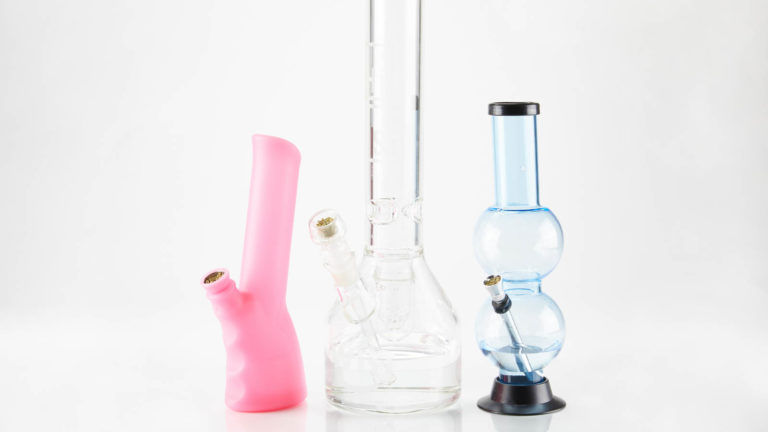 Photo by: Gina Coleman/Weedmaps
Photo by: Gina Coleman/WeedmapsImage lightbox

What is a Bong?
The word bong is adapted from the Thai word baung (บ้อง), meaning a wooden cylinder or pipe cut from bamboo and used for smoking. Whether manufactured or homemade, the device as we know it stays essentially true to this definition of a bong. It's central identifying shape — the cylindrical neck — mirrors the robust cylinder of a bamboo stalk.
The bong's neck, vessel, or tube connects to the base where the water resides. Bongs are frequently custom-made or homemade, and come in a vast amount of shapes, sizes, and modifications, such as neck pinches or gravity chambers. Some bongs are just a single straight tube that connects to the mouthpiece. Others have a wide base (usually beaker-shaped or spherical) that connects to the tube.
The only other essential parts of a bong are the bowl and downstem. Though most professionally crafted bongs are glass, homemade bongs can be constructed from any vessel that is both airtight and watertight by adding a stem, bowl and carb apparatus.
What is a Bong Used For?
Advantages of Bongs
A major reason for the bong's popularity is that it's easy to use. The best bongs offer the simplicity and immediacy of a dry flower pipe while facilitating a smoother hit by eliminating harsh dry smoke through water filtration. Bongs offer particularly cool hits when ice is added to the water.
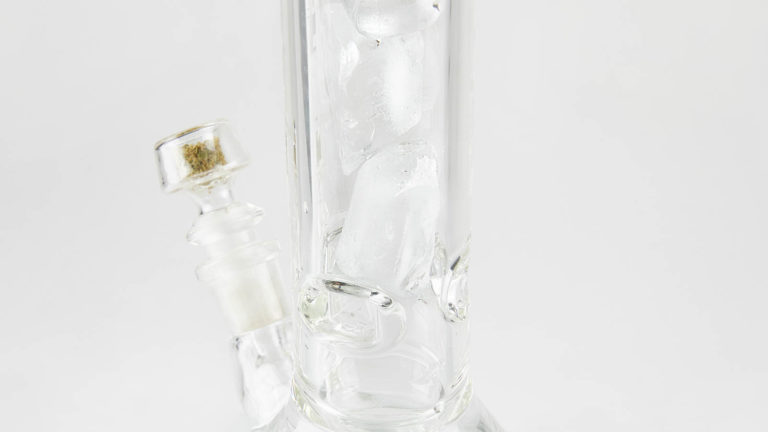
Image lightbox

It's generally easier to learn how to use a bong than it is some other popular smoking devices. Bongs require less prep work than a joint and typically offer a stronger hit than a dry flower vaporizer. Small bowls still provide a fresh hit, and, unlike smoking a joint, don't start to taste bad from tar buildup.
Do Bongs Filter Smoke?
Studies on tobacco and cannabis have shown that water pipes can filter out carcinogens and other toxicants produced by burning cannabis, especially if they are equipped with a diffuser or percolator. Passing either marijuana or tobacco smoke through water has been shown to remove the presence of cytotoxins acrolein and acetaldehyde. These cytotoxins are present in both marijuana and tobacco, and are harmful to major lung defense cells.
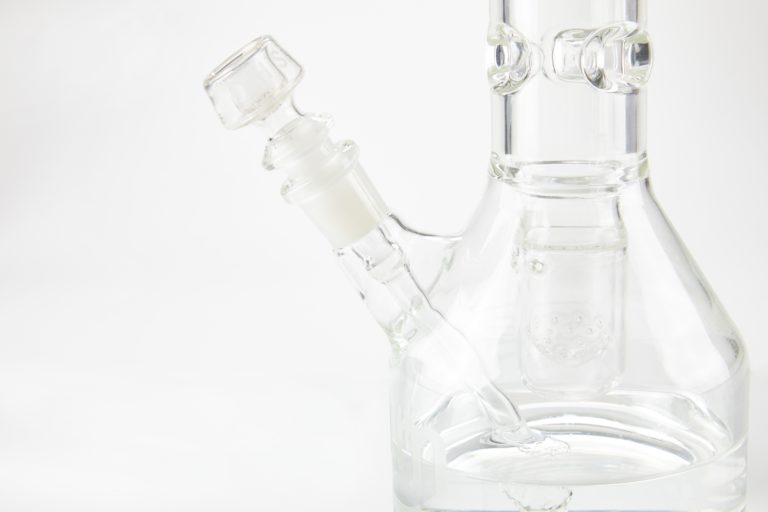 Photo by: Gina Coleman/Weedmaps
Photo by: Gina Coleman/WeedmapsImage lightbox

Disadvantages of Bongs
A bong's central purpose is to cool and filter smoke through water filtration. While it results in a smoother smoke, however, it can also filter out some THC and other psychoactive compounds. In fact, water pipes filter out more cannabinoids than tar. And filtering out cannabinoids means the user has to smoke more to get the desired effect.
Many of the best bongs also require higher upfront cost than a blunt or joint. When you know how to use it, a well-made, well-maintained bong can last a lifetime, but it may also put you back a pretty penny upon initial purchase. Bongs can range in price anywhere from $10 to thousands of dollars for an artisan piece.
And while bongs may require less prep work than a joint, bongs do require a lot more maintenance and upkeep. If you don't keep changing the water, a bong can become increasingly difficult to clean. New bong users should also be aware: Bong water smells foul. The scent of bong water isn't necessarily a disadvantage that affects its function, but the odor is generally unpalatable to cannabis users.
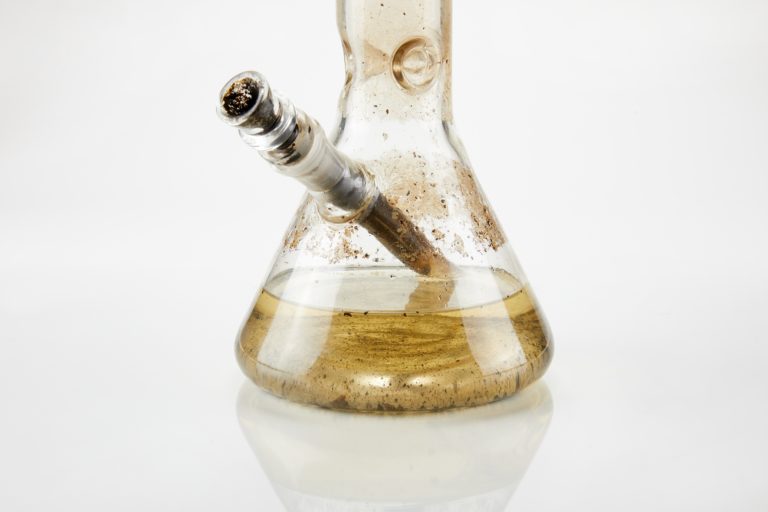 Photo by: Gina Coleman/Weedmaps
Photo by: Gina Coleman/WeedmapsImage lightbox

History of the Bong
The exact origin and evolution of the bong remains somewhat cloudy. Because cannabis originated in central Asia, archaeologists have assumed that the bong shares this origin point, and descended from the hookah. However, archaeological findings over the course of several decades present the greater likelihood that the bong originated in Africa.
Archaeologist J.C. Dombrowski excavated the earliest known water pipes in Ethiopia in 1971, dating them between 1100 and 1400 BCE. In 1924, Arthur Dunhill noted in a study on water pipes of Africa that the absence of smoking apparatus in Europe is a clear indicator of its origin. According to Dunhill, the San people of Southern Africa created a tube pipe with a bowl on top and round water chamber at the bottom, connected by a curved tube. Dunhill's theory that this was the birth of the water bong is in relative competition with Dombrowski's findings, but both still provide further evidence of the bong's African origins.
African pipes were long thought to be used exclusively for tobacco smoking, which also contributed to the dominant Asia origin story. But traces of cannabis residue reveal that Dombrowski's early African water bongs were definitely used to smoke cannabis. Several origin theories for the bong, as well as how it spread throughout the world, remain in competition, so a settled place and time for the first bong continues to be cloudy. However, the most current and plausible research suggests that these early African water bongs are the world's first.
Bongs may not have originated in Central Asia, but they certainly gained popularity in 16th century China during the late Ming dynasty. Popular theory suggests that these water pipes spread throughout Europe, the Middle East, and east Asia along the Silk Road. As cannabis gained popularity across the globe, so did water bongs and other smoking accessories. Time shaped the evolution of the bong as manufacturers began experimenting with different materials, shapes, and sizes.
The Bong Renaissance
The glass industry flourished in the United States during the 19th century, which eventually gave way to the 20th century bong boom in the 1960s and 1970s. Bob Snodgrass, called the godfather of the bong renaissance, designed glass bongs across the United States while traveling on tour with the Grateful Dead.
Snodgrass eventually settled in Eugene, Oregon, and began teaching others the craft of homemade bong-making. He also discovered “fuming,” which uses gold and silver to color borosilicate glass. From there, his students multiplied, at the same time head shops were popping up in every major metropolitan area of the U.S. in the '90s.
Today, the best bongs serve as more than a smoking device. In the tradition of Snodgrass, glass blowers have created an art surrounding the craft of bong-making. Thanks to the craftiness of the cannabis community, water bongs are now a highly functional, interactive art piece.
The Resurgence of American Pipemaking
Are Bongs Illegal?
Unless considered smoking devices meant for legal substances like tobacco and not exclusively for smoking federally illegal substances such as cannabis, a bong is considered illegal drug paraphernalia under the Controlled Substances Act. Operation Pipe Dreams was a 2003 federal sting operation by the U.S Department of Justice against dozens of glassblowers they identified as “illegal drug paraphernalia sellers.” Among the glassblowers was comedian and cannabis culture icon Tommy Chong. The glassblowers were charged with “trafficking of illegal drug paraphernalia,” and Chong's nine-month jail sentence sparked a controversy that galvanized a generation of glass artists to join the movement and make glass pipes and water bongs for cannabis use. Soon, this underground movement of glass pipe-making would permeate the growing post-legalization cannabis culture.
How to Use a Bong
Trying out a new or unfamiliar method of smoking can be overwhelming and confusing for new users. Bongs may be easy to use, but newcomers may still find them daunting. If you don't know how to use a bong, or you're worried about smoking from a bong for the first time, remember the following steps until you've had enough practice to perfect your routine:
- Fill the bong with water. Pour directly into the mouthpiece. When the water bong is filled, the downstem should be submerged no more than an inch inside the bong. Any more water than that, and you might end up inhaling some liquid when trying to smoke.
- Prepare your cannabis. Grind up your cannabis with a grinder or pair of scissors, or break it up with your hands if you don't have a grinding tool available.
- Pack the bowl. Don't pack your bowl too tightly, though. Make sure there's room so air can still pass through.
- Get ready to rip.
- Hold the bong with your non-dominant hand, and the lighter in your dominant hand.
- Take a few deep breaths to get the oxygen flowing so it's easier to inhale a big helping of bong smoke.
- Finally, put your mouth on the mouthpiece. Create a tight seal by placing your lips fully inside with the rim of the mouthpiece.
- Light the bowl. Light your lighter, tilt it over the bowl, and slowly inhale to draw smoke up the tube.
- Smoke away! Once you've drawn enough smoke into the tube, pull the bowl from the downstem and inhale the smoke. Hold the smoke for two to three seconds, then exhale.
Why do Bongs Hit Harder?
A bong's large chamber and water filtration system allows you to get a bigger hit of cooler smoke in a greater quantity than a pipe or joint. It can be difficult at first to know how to use a bong without over-inhaling and coughing. It's best to start out by taking slow, conservative hits, then adjust your inhalation once you get the hang of the process.
Key Components
A bong's form follows its function. A minimal set of simple, functional, and indispensable components make the bong instantly identifiable, no matter how minimal or elaborate the ornamental details.
The essential components found in almost every water bong include:
Tube: Also known as the vessel or neck, the tube is the cylinder that conducts the smoke and air into the user's mouth. There are generally three different tube types; straight, angled, and custom.
Base: The chamber that fills with water. The base is the lower portion of the bong and usually the largest and widest. Bongs are often categorized by their base type; usually straight, beaker, or round base. The straight-tube bong is the classic design, consisting of a single cylinder as the main body. Beaker bongs have a conic or beaker-shaped base. Round bases have a spherical base and flat bottom. Beyond possible changes in airflow, there isn't much difference between the smoking mechanics of the three types.
Downstem: A connective piece of glass that is inserted through the base and into the water. This is the part that initiates the filtration. The two most popular downstems are classic and diffused. A classic downstem is a solid cylinder while a diffused downstem has extra holes or slits that diffuse and cool the smoke while providing a smoother pull. The downstem, like the bowl, can be male or female. If the downstem is male, the bowl is considered female, and vice versa.
Bowl: The bowl is what holds the herb atop the downstem. Bowls most commonly come in one of three sizes, 10 mm (small), 14 mm (medium), 19 mm (large). Downstems also have these sizes. For male bowls, the size is the outer circumference of the fitting end. For females, it's the inner circumference.
Advanced Designs and Stemless Bongs
The culture of custom bong-making has led to the development of several advanced bong designs. A gravity bong has a glass percolator in the base of the bong where smoke is diffused through its multiple arms. Multi-chamber bongs offer more chambers, usually within the tube or base, to filter and cool the smoke. Stemless bongs connect directly to the base, usually at a 90-degree angle, which improves diffusion while making the whole bong one elegant, flowing piece.
Accessories
Most water bong accessories are advanced filtration designs that can enhance a person's smoking experience and improve the overall function of a water pipe.
Percolator: a diffuser that smooths and cools smoke, usually found in the tube. The most common types of percolators include:
- Honeycomb: a disc filled with tiny holes that breaks down bubbles.
- Turbine: cut discs lining the tube that cause diffusion with a whirlpool effect.
- Fritted discs: a glass disc that allows for optimal diffusion through its porous surface.
- Tree: usually made up of several downstem-shaped diffusion arms with slits on the end.
Carb: A hole usually located between the neck and base of the bong used to control air and smoke intake. Smokers rest their thumb over the hole of the carb while lighting the herb, then remove their thumb to clear out all of the smoke and allow air to fill the neck of the bong. Not all bongs have carbs built into them, but most pipes do.
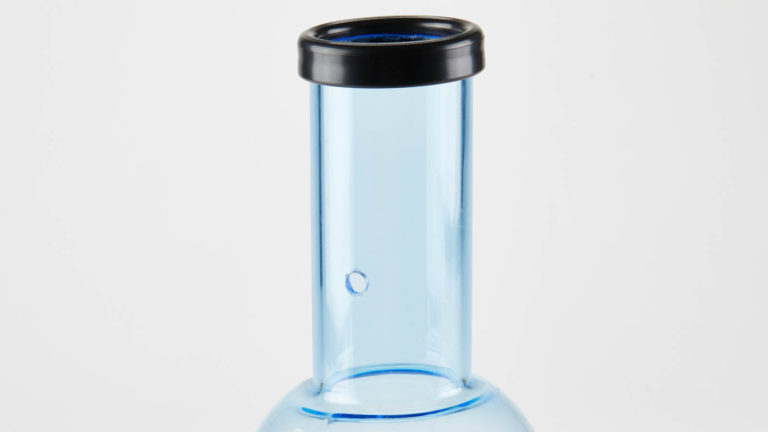
Image lightbox

Rubber grommet: A rubber circular piece that rests in the hole where the downstem goes through the bong. Some bongs do not have a rubber grommet, but instead have a glass holder attached to the opening for the downstem to go through. Typically, both parts of a glass-on-glass connection will be sandblasted to make separating the two pieces easier.
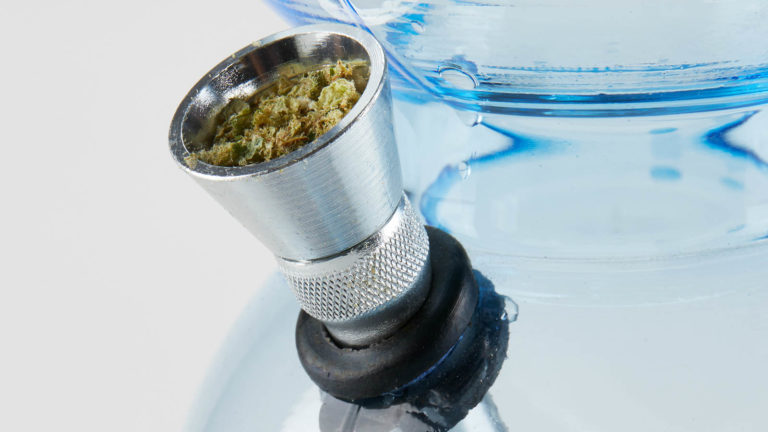
Image lightbox

Ice pinch: A series of glass indentations, usually three, that are large enough to hold ice within the neck of the bong without interfering with or blocking any smoke.
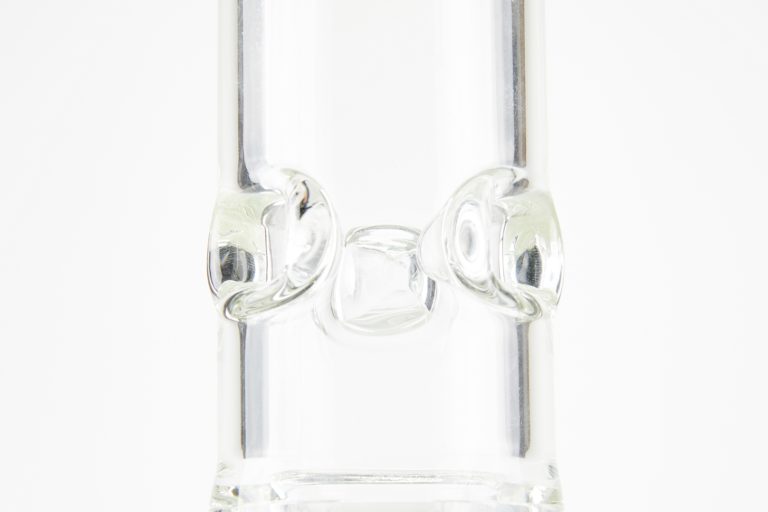
Image lightbox

Splash guard: A dome that catches water while allowing smoke to pass through.
Materials
 Photo by: Gina Coleman/Weedmaps
Photo by: Gina Coleman/WeedmapsImage lightbox

Even the best bongs can be made using a variety of materials. For those who love artistry, a glass bong is the way to go. Glassblowing has been a tried and true method for creating smoking accessories throughout the decades. If you're in the market for something a little more durable — we all have that friend who drops everything — try plastic or silicone. The material you choose is more about the intended use than the quality of the material itself.
Glass
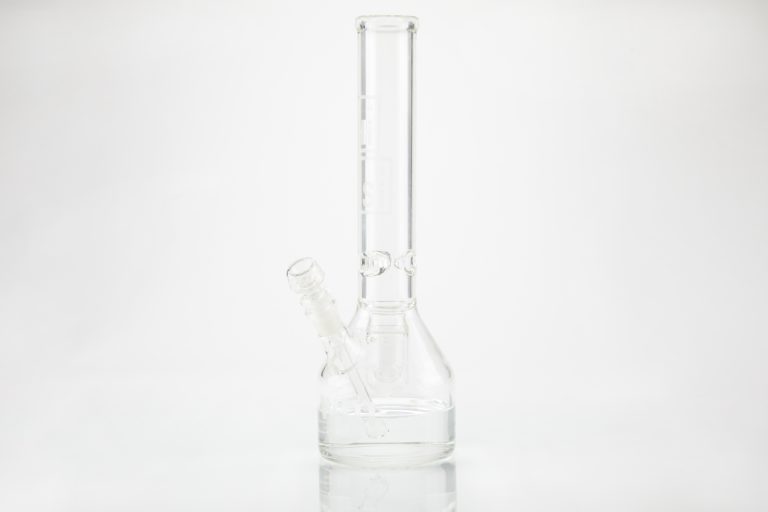 Photo by: Gina Coleman/Weedmaps
Photo by: Gina Coleman/WeedmapsImage lightbox

Glass bongs are undeniably the most popular, highly valued for the way they preserve the taste and purity of cannabis smoke. The transparency of glass also gives users a better idea of where and when their water bong needs to be cleaned. Glass bongs are typically the most expensive. They're also fragile, and therefore more challenging to transport.
Bamboo or Wood
Bongs made of bamboo or wood are exceptionally sturdy and much cheaper than glass bongs. With proper maintenance and upkeep, they can last a lifetime. Unfortunately, they're also difficult to clean.
Plastic
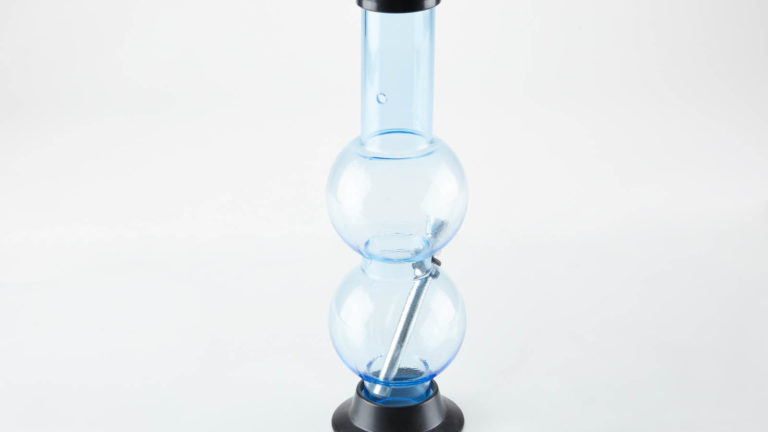
Image lightbox

Plastic bongs are the least expensive bongs on the market. And they'll last an incredibly long time for a relatively small investment. They're also easy to pass around with friends.
Silicone
Silicone bongs have gained a lot of traction in recent years. They're much more durable than glass bongs, and they're easy to clean. One disadvantage of a silicone bong, though, is the mild plastic taste you'll inevitably get with most hits.
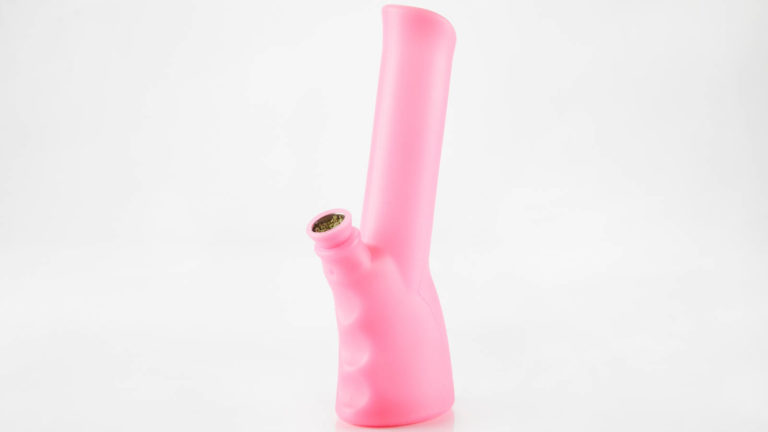
Image lightbox

Ceramic
Ceramic bongs are fragile, like glass, and typically heavy. They are also cheap, which makes their fragility less of a problem, and great for displaying creative designs. They're much easier to replace than glass water bongs.
How to Clean and Maintain a Bong
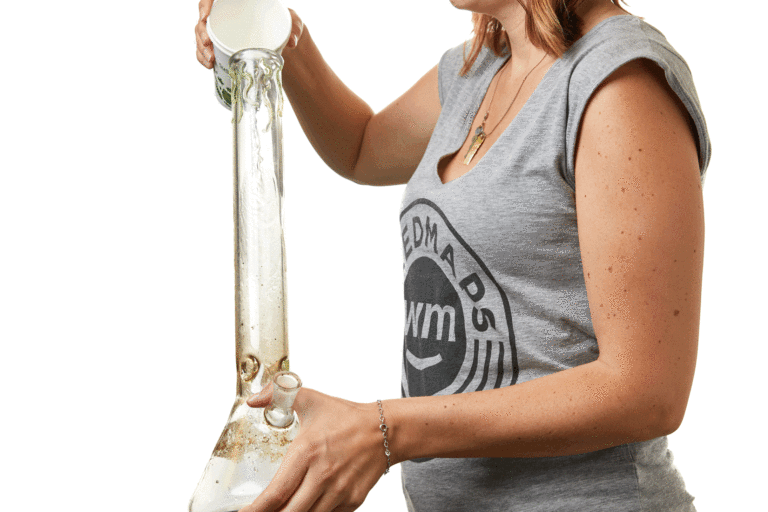
Image lightbox

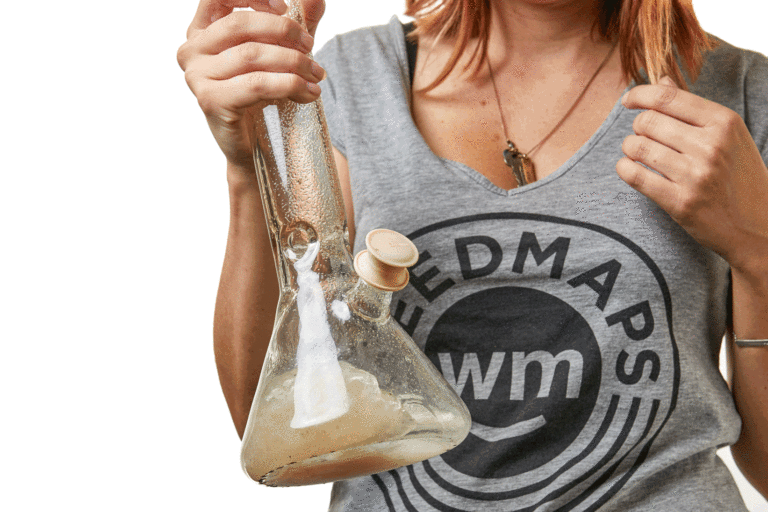
Image lightbox

Why do Bongs Get Dirty?
Part of knowing how to use a bong is knowing how to clean it. Keeping your bong clean will not only keep it looking nice, but it also will ensure a clearer, purer flavor when you smoke. Without regular and proper cleaning, bong water can build up ash that gets pulled through the bowl, as well as bacteria and resin inside the base and tube.
When cleaning your bong after a heavy smoke session, the simplest method is to combine alcohol and salt. Retailers often have cleaners specially formulated for use on cannabis accessories.
Remove the bowl and downstem when possible, add alcohol (90% isopropyl, or rubbing, alcohol is recommended) ,and shake it around. The alcohol should break down leftover resin. If it doesn't, add some salt and shake further. If there is still residue, you may need to let the alcohol soak for 24 hours. When you dump the alcohol, rinse the bong thoroughly with warm water.
Once you've cleaned your bong with alcohol, set it by the window to allow the sun to heat it up. This will help the alcohol break down the resin further. For bongs with hard-to-reach areas, try using pipe cleaners or cotton swabs. Make sure to rinse every piece thoroughly with water.
If your bong is in need of heavy-duty cleaning, try pre-soaking it in warm water. If you're working with particularly nasty stains, add dish soap to your pre-soak, but only a small amount. Too much could leave you with a soapy aftertaste during your next few sessions.
Maintaining a bong doesn't require much more than adhering to a few best practices.
- Change the water after each use.
- Use filtered water to avoid water spots.
- Dump the ash from your bowl frequently to avoid pulling it through during use. This will also ensure you don't get globs of resin in your bong.
- If you're a heavy bong user, clean your bong as regularly as possible.
How to Make Your Own Bong at Home
The simplicity of the bong makes it relatively simple to replicate. Over the course of the bong's history, only a select few homemade and DIY bong traditions have cemented themselves into the culture.
Watermelon and Carrot
Using a watermelon and carrot as a base and bowl/downstem, respectively, is a very popular mode of homemade and DIY bong-making. To make a watermelon-and-carrot bong at home, you'll need the following tools:
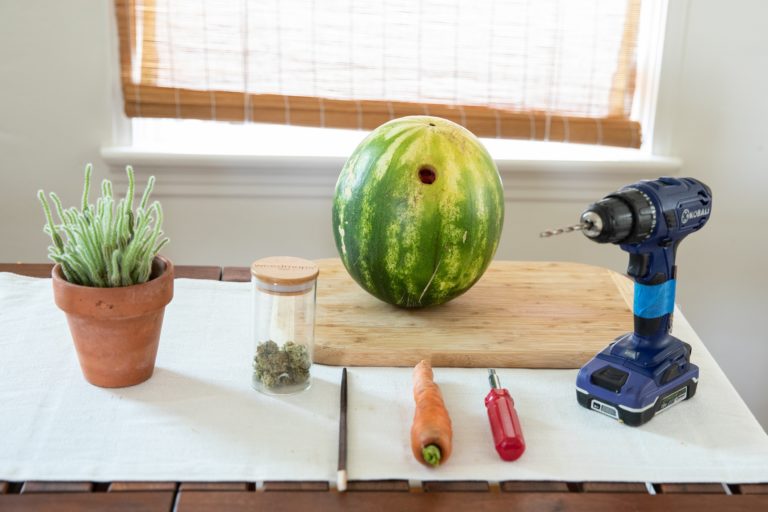
Image lightbox

- Watermelon
- Carrot
- Screwdriver or drill bit to carve out carrot
- Cannabis
As you may have guessed, the watermelon is the vessel, and the carrot is the downstem and bowl. Now, you may be thinking, “wait a minute, you forgot the water for this DIY water bong.” With a watermelon and carrot, you don't need to add water because you can just use the watermelon juice.
How to Make a Watermelon-and-Carrot Bong
Making a DIY bong out of a watermelon and carrot requires the following steps:
- Make three holes on the watermelon: one large hole for a mouth piece, one small hole for a carb cap, and one for the carrot (bowl and downstem).
- Use a drill bit or screwdriver to poke a hole through the carrot.Shape one end to be a bowl.
- Stick the carrot in the watermelon.
- Pack the carrot with cannabis and smoke.
Some users may be more interested in the popular variations on the watermelon-and-carrot concept. Using a bell pepper and carrot, for example, is a popular alternative. The major difference between the bell pepper bong and the watermelon bong is that you need to add water to the bell pepper. The advantage to this is that the bell pepper can easily be used multiple times. Using a pineapple and carrot is also popular, though more difficult to make due to the tough, dense texture of the pineapple.
Other DIY Bong Options
Plenty of other creative DIY bong concepts exist. To get your creativity flowing, here are a few:
- How to Make an Apple Bong
- How to Make a Water Bottle Bong
- How to Make a Watermelon Bong
- How to Make a Pumpkin Bong (perfect for Halloween!)
Gravity Bong
A homemade or DIY gravity bong consists of two containers, usually a bucket and a 2 liter bottle. The larger container is full of water, and forces smoke into the smaller container for inhalation.
The required tools to make a gravity bong are:
- 2 liter bottle
- Scissors
- Bowl
- Cannabis
- Bucket or bathtub
- Water
How to Make a Gravity Bong
Gravity bongs are another common type of bong. A quick summary is below, but more detailed instructions can be found on our how to make a gravity bong page.
- Cut the bottom out of a 2 liter bottle.
- Poke a hole in the cap that is large enough to fit a bowl but small enough to be airtight.
- Fill the bucket with water.
- Pack the bowl and place in the cap, leaving it to the side until ready to smoke.
- Without the cap, place the bottle inside of the water, leaving enough room to screw on the cap without the bowl touching the water.
- Screw the cap with the loaded bowl onto the bottle.
- Spark your lighter and slowly pull the bottle out of the water until there is roughly 1-2 inches, or 2.54 to 5 centimeters, left underwater.
- Remove the cap and place your mouth on the top of the bottle.
- Move the bottle toward the bottom of the bucket while inhaling all of the smoke.
Frequently Asked Questions
Does Drinking Bong Water Get You High?
No, drinking bong water won't get you high. Cannabinoids are not water-soluble, which means they do not bind to water. THC's solubility in water is about two micrograms per milliliter of water. It won't be enough to get you high and will definitely not be worth the flavor of the bong water or risk of upsetting your stomach.
Can You Hit a Bong Without Water?
Yes, but that defeats the purpose of smoking out of a bong. The water in a bong helps filter the smoke to result in a more smooth hit.
Can You Smoke a Bong with a Different Liquid Other than Water?
Yes, but it is not recommended.
Do Bongs Get You Higher?
A 2000 study from NORML found that bongs do not get you higher than pipes. However, bongs allow for a larger hit than other consumption methods, like pipes or joints. By taking larger hits, you can get high quickly, but how high you'll get depends on a variety of factors including the potency of the weed and the makeup of your endocannabinoid system.
How Much Do Bongs Cost?
Bongs range in price from $20 to $20,000. A variety of factors go into the cost of a bong, including the material, style, and glassblower. Different types of glass have different price points. Before purchasing a bong it's best to set your budget and search for options in your price range.
Sources
Cozzi, Nicholas V. “Effects of Water Filtration on Marijuana Smoke.” Newsletter of the Multidisciplinary Association for Psychedelic STudies, vol. 4, no. 2, 1993.
Huber, Gary L., et al. “Marijuana and Tobacco Smoke Gas-Phase Cytotoxins.” Pharmacology Biochemistry and Behavior, vol. 40, no. 3, 1991, pp. 629–636., doi:10.1016/0091-3057(91)90374-b.
Philips, John Edward. “African Smoking and Pipes.” The Journal of African History, vol. 24, no. 03, July 1983, p. 303., doi:10.1017/s0021853700022039.
Gieringer, Dale. “The California NORML/MAPS Smoking Device Study.” California NORML, www.canorml.org/healthfacts/smokestudy.html.

